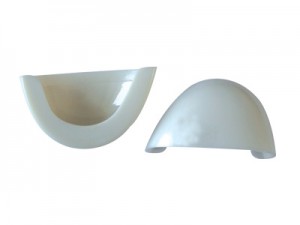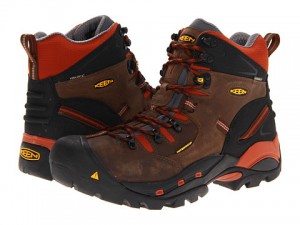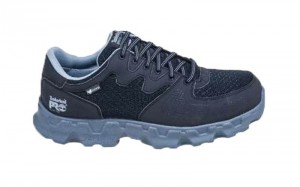We get many people in the Portland area concerned with a few myths about Steel Toed boots. Let’s see if I can clear up the top four concerns as follows:
- Steel Toes will amputate your toes on impact: This issue was tested on episode #42 of the MythBusters TV show. I have attached a copy of the written findings from MythBusters below. The bottom line is that if you work in an environment where heavy material, parts and or hand trucks, forklifts and other items are present you are better off with them than without them.
- Steel Toed boots bother my toes: Steel toe footwear production has changed a lot over the past 20 years. In the early days there were not many options for a steel toe, all steel toes were purchased from one or two suppliers and were in fact on the narrow side. Today, we have many options with wider, taller steel toes – with many of the brands creating their own steel toes for a better, more comfortable fit. The key is to make sure to get fitted properly for a steel toed boot.
- Steel Toed Boots are too heavy: The fact is that steel toes do add weight to the footwear, however it is minimal and not the only reason they tend to weigh more. Most, if not all, of steel toed footwear is designed and manufactured to be an industrial grade boot using better, thicker leathers, midsole materials and outsole materials – designed for longevity in the work place. There are now other safety toe material options such as Alloy and Composite which reduce weight slightly.

Composite Safety Toe Cap
- Steel Toed boots are not stylish: Times change, we now have many very stylish steel toed boots and shoes. They are not what grandpa used to wear… there are now steel toe hiking boots, trail shoes and athletic shoes available. These tend to be less weight than the standard work boots and generally provide more cushioning and will look very much like a standard hiking, trail or athletic shoe.

Keen Hier Safety Toe Boot

Timberland Safety Toe Shoe
Hope this information helps! Regards, Victor
MythBusters Episode 42: Steel Toe Amputation, Bottle Rocket Blast Off
- You can launch someone 30-40ft with a bottle-rocket-powered backpack: mythbusted (the engineering on this one was a bit questionable)
- Steel toe boots have a higher amputation risk than regular boots: mythbusted
Steel Cap Amputation
Myth: Steel-toed boots are more dangerous than regular boots — if something falls on the boots, the steel can curl in and cut off your toes.
They were able to find one occurrence of amputation while wearing steel-toed boots occurring in real life. In 2002, an Australian worker lost his 3rd toe when some steel pipes feel from a forklift.
Adam and Jamie constructed various tests for this myth using both a guillotine toe-smasher and an arbor-press. Initially they used frangible feet that Adam made, but it turned out that they made a mistake in assuming that their frangible feet would model real human feet being crushed. For better comparisons they ended up using clay.
Frangible Feet Construction
Adam constructed frangible feet to test with based on landmine frangible feet. After testing chicken legs, bamboo, and fiberglass as substitutes for human bones, he decided to use fiberglass bones. The bones were set in a ballistics gel cast of Adam’s leg.
For those wondering, the full frangible leg construction process was:
- Pour dental alginate over leg and surround with plaster bandages to get leg mold. (link to website on making plaster casting with dental alginate)
- Fill alginate mold with silicon-based rubber to make a rubber leg
- Make plaster mold of rubber leg
- Make a plaster mold of a skeletal foot
- Fill mold with hard resin fiberglass cocktail to make bones
- Use hot glue gun to make tendons to connect bones
- Place resin bones inside plaster leg mold and fill with ballistics gel mix (used a different ballistics gel mix than usual)
Guillotine drop test 1
NOTE: in turned out that the results from this test were somewhat invalid. After testing with the steel-toed boots they tested with the regular boots and discovered that the ballistics gel was too springy and was invalidating their results. While ballistics gel is good for simulating bullet impacts on flesh, it’s not so good for testing crushing.
Setup:
- Guillotine-style toe crusher that drops a flag metal bar onto the toe of a boot beneath.
- Used the highest-rated (ANSI-75) steel toe boots.
Results:
- 75lbs from 3 feet (official ANSI test height and weight): mashed the leather down a bit, but nothing injurious.
- 400lbs from 3 ft: more deformation in the steel plate, but only damage to frangible foot was a broken metatarsal (big toe). Adam: “I want to see some toes cut off or crushed beyond all recognition”
- 400lbs from 6 ft: a lot of pancaking of steel cap and lots of broken bones beneath, but no toe amputation.
They didn’t detail the results from the regular boot because of their discovery about the ballistics gel being too springy.
Guillotine drop on boots filled with clay
Because of the ballistics gel problem they decided to use clay instead of the frangible bone legs they had constructed. Clay is the method ANSI uses to test boots.
At the official test height of 3ft with 75lbs there was 0.5″ of clay compression with the steel-toe boot, which is exactly to spec. The regular boot failed horribly, with the clay being completely splattered.
Arbor press test to find total failure point
They used an arbor press to squish boots to their total failure point. The steel-toe boot was able to take 6000lbs of pressure before total failure; the regular boot was only able to take about 1200lbs, which was hard to measure as it failed so quickly.
Shearing attachment tests
In order to test a worst case scenario, they made a shearing attachment, which was a thin metal plate that would hit the boot on edge.
They mounted the shearing attachment to the arbor press: at 750 lbs it broke every bone in the frangible foot; at 1400 lbs it severed all the bones in the feet.
They then mounted the shearing attachment on the guillotine and raised it to it’s max height of 6ft and max weight of 400lbs. The blade glanced off the steel plate, shearing the entire shoe in half. They tested again and got the same result. In this particular scenario, were a heavy blade to drop on your foot you could actually lose more of your foot as the steel cap could direct the glade further up the foot as it did in the test. This isn’t the failure mode described in the tests, though, and regardless of what type of boot you used there would be amputation.
Mythbusted: They had to mount a blade in order to get amputation with the steel toe boot and all their other tests showed much more damage to the foot when regular boots are used.
